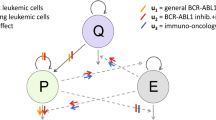Abstract
We propose and analyze a simplified version of a partial differential equation (PDE) model for chronic myeloid leukemia (CML) derived from an agent-based model proposed by Roeder et al. This model describes the proliferation and differentiation of leukemic stem cells in the bone marrow and the effect of the drug Imatinib on these cells. We first simplify the PDE model by noting that most of the dynamics occurs in a subspace of the original 2D state space. Then we determine the dominant eigenvalue of the corresponding linearized system that controls the long-term behavior of solutions. We mathematically show a non-monotonous dependence of the dominant eigenvalue with respect to treatment dose, with the existence of a unique minimal negative eigenvalue. In terms of CML treatment, this shows that there is a unique dose that maximizes the decay rate of the CML tumor load over long time scales. Moreover this unique dose is lower than the dose that maximizes the initial tumor load decay. Numerical simulations of the full model confirm that this phenomenon is not an artifact of the simplification. Therefore, while optimal asymptotic dosage might not be the best one at short time scales, our results raise interesting perspectives in terms of strategies for achieving and improving long-term deep response.








Similar content being viewed by others
References
Breccia M, Cannella L, Stefanizzi C et al (2010) Cytogenetic and molecular responses in chronic phase chronic myeloid leukaemia patients receiving low dose of imatinib for intolerance to standard dose. Hematol Oncol 28:89–92
Chu S, McDonald T, Lin A, Chakraborty S, Huang Q, Snyder DS, Bhatia R (2011) Persistence of leukemia stem cells in chronic myelogenous leukemia patients in prolonged remission with imatinib treatment. Blood 118(20):5565–5572
Clairambault J, Gaubert S, Lepoutre T (2011) Circadian rhythm and cell population growth. Math Comput Model 53(7–8):1558–1567
Clapp GD, Lepoutre T, El Cheikh R, Bernard S, Ruby J, Labussière-Wallet H, Nicolini FE, Levy D (2015) Implication of the autologous immune system in BCR-ABL transcript variations in chronic myelogenous leukemia patients treated with imatinib. Cancer Res 75(19):4053–4062
Deininger MWN, Goldman JM, Melo JV (2008) The molecular biology of chronic myeloid leukemia. Blood 96(10):3343–3356
Doumic-Jauffret M, Kim PS, Perthame B (2010) Stability analysis of a simplified yet complete model for chronic myelogenous leukemia. Bull Math Biol 72(7):1732–1759
Foo J, Drummond MW, Clarkson B, Holyoake TL, Michor F (2009) Eradication of chronic myeloid leukemia stem cells: a novel mathematical model predicts no therapeutic benefit of adding G-CSF to imatinib. PLoS Comput Biol 5(9):e1000503
Glauche I, Horn K, Horn M, Thielecke L, Essers MAG, Trumpp A, Roeder I (2012) Therapy of chronic myeloid leukaemia can benefit from the activation of stem cells: simulation studies of different treatment combinations. Br J Cancer 106(11):1742–1752
Graham SM, Jorgensen HG, Allan EK, Pearson C, Alcorn MJ, Richmond L, Holyoake TL (2002) Primitive, quiescent, Philadelphia-positive stem cells from patients with chronic myeloid leukemia are insensitive to STI571 in vitro. Blood 99(1):319–325
Hehlmann R, Müller MC, Lauseker M et al (2014) Deep molecular response is reached by the majority of patients treated with imatinib, predicts survival, and is achieved more quickly by optimized high-dose imatinib: results from the randomized CML-Study IV. J Clin Oncol 32(5):415–423
Kim PS, Lee PP, Levy D (2008a) A PDE model for imatinib-treated chronic myelogenous leukemia. Bull Math Biol 70(7):1994–2016
Kim PS, Lee PP, Levy D (2008b) Dynamics and potential impact of the immune response to chronic myelogenous leukemia. PLoS Comput Biol 4(6):e1000095
Kim PS, Lee PP, Levy D (2008c) Modeling imatinib-treated chronic myelogenous leukemia: reducing the complexity of agent-based models. Bull Math Biol 70(3):728–744
Komarova NL, Wodarz D (2007) Effect of cellular quiescence on the success of targeted CML therapy. PLoS ONE 2(10):e990
Mahon FX, Réa D, Guilhot J et al (2010) Discontinuation of imatinib in patients with chronic myeloid leukaemia who have maintained complete molecular remission for at least 2 years: the prospective, multicentre Stop Imatinib (STIM) trial. Lancet Oncol 11(11):1029–1035
Michor F, Hughes TP, Iwasa Y, Branford S, Shah NP, Sawyers CL, Nowak MA (2005) Dynamics of chronic myeloid leukaemia. Nature 435:1267–1270
O’Brien SG, Guilhot F, Larson RA et al (2003) Imatinib compared with interferon and low-dose cytarabine for newly diagnosed chronic-phase chronic myeloid leukemia. N Engl J Med 348(11):994–1004
Preudhomme C, Guilhot J, Nicolini FE et al (2010) Imatinib plus peginterferon alfa-2a in chronic myeloid leukemia. N Engl J Med 363(26):2511–2521
Roeder I, Herberg M, Horn M (2009) An “age”-structured model of hematopoietic stem cell organization with application to chronic myeloid leukemia. Bull Math Biol 71(3):602–626
Roeder I, Horn M, Glauche I, Hochhaus A, Mueller MC, Loeffler M (2006) Dynamic modeling of imatinib-treated chronic myeloid leukemia: functional insights and clinical implications. Nat Med 12(10):1181–1184
Ross D M, Branford S, Seymour J F et al (2010) Patients with chronic myeloid leukemia who maintain a complete molecular response after stopping imatinib treatment have evidence of persistent leukemia by DNA PCR. Leukemia 24(10):1719–1724
Rousselot P, Huguet F, Rea D, Legros L, Cayuela JM, Maarek O, Blanchet O, Marit G, Gluckman E, Reiffers J, Gardembas M, Mahon FX (2007) Imatinib mesylate discontinuation in patients with chronic myelogenous leukemia in complete molecular remission for more than 2 years. Blood 109(1):58–60
Stiehl T, Baran N, Ho AD, Marciniak-czochra A, Stiehl T, Baran N, Ho AD, Marciniak-czochra A (2014) Clonal selection and therapy resistance in acute leukaemias: mathematical modelling explains different proliferation patterns at diagnosis and relapse. J R Soc Interface 11(94):20140079
Valent P (2008) Emerging stem cell concepts for imatinib-resistant chronic myeloid leukaemia: implications for the biology, management, and therapy of the disease. Br J Haematol 142(3):361–378
Author information
Authors and Affiliations
Corresponding author
Rights and permissions
About this article
Cite this article
Besse, A., Lepoutre, T. & Bernard, S. Long-term treatment effects in chronic myeloid leukemia. J. Math. Biol. 75, 733–758 (2017). https://doi.org/10.1007/s00285-017-1098-5
Received:
Revised:
Published:
Issue Date:
DOI: https://doi.org/10.1007/s00285-017-1098-5



